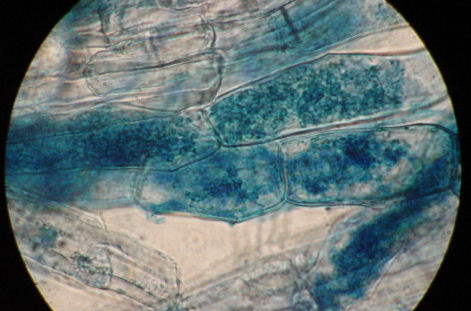|
MycorrhizasSoil ecology in woodland is very different to that in agriculture or productive gardens. An important class of fungi known as mycorrhizas, have specific symbioses with higher plants. The structure of the relationship is developed in the roots and spreads as a mycelial network throughout the soil. The photo shows a slide of root cells of cherry colonised by a vesicular-arbuscular mycorrhizal fungus.
Mycorrhizas are very normal not just in woodland, but between the majority of plants and in a wide variety of situations. But in woodland, the network can remain undamaged by operations if done in the right conditions. The result of this pre existing mycelial network is rapid establishment, as seedlings become naturally inoculated by their partners. Nutrients, minerals, gasses and water are very efficiently fed back to the plant. This is because the hyphal network has a much finer and more pervasive access to the micropores of the soil than the plant roots alone. In exchange, and as the plant grows, it leaks excess sugars from photosynthesis through its roots, to develop the fungal body in the soil. As a result, more carbon is stored below ground in mycorrhizal systems than is stored in the wood above ground. Undamaged forest soils are therefore very carbon rich and should be valued as a resilient buffer against climate change. |
